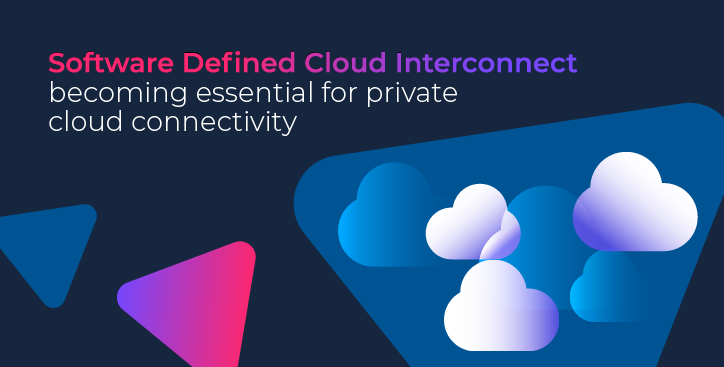Software Defined Cloud Interconnect becoming essential for private cloud connectivity
By Alex Hawkes|16 April, 2024

For enterprises using both hybrid- and multi-cloud architectures, Software Defined Cloud Interconnects (SDCIs) are increasingly well-recognised as the most advantageous approach to private cloud connectivity.
In fact, by 2027 Gartner® predicts 30% of enterprises will employ SDCI services to connect to public cloud service providers. This is a threefold increase from less than 10% in 2022.
According to Gartner, concurrent with the broader adoption of cloud-based IT for mission-critical workloads are enterprises’ requests for agility, predictability and high performance in their connections to the cloud - features that internet-based interconnects cannot always guarantee.
So, SDCI is fast emerging as the infrastructure glue between public cloud service providers, internet service providers (ISPs), network service providers (NSPs), and on-premise infrastructure assets.
Why is Software Defined Cloud Interconnect becoming essential?
As enterprises add more public cloud providers and more regions or availability zones, even in a mono-cloud environment, the network is becoming more complicated, requiring more accessible private cloud connectivity options for mission-critical applications.
Currently, the public internet is the most popular way for enterprises to connect its end-users to data and applications in the cloud. However, the more enterprises rely on hybrid cloud and multi-cloud approaches for their business requirements, and the more these deployments support business-critical and performance-sensitive applications, the greater the need for dependable cloud connectivity.
Greater requirements for reliable, high-performing and secure connections to the cloud fuel demand for uncontended, high-speed and private options. This is especially true for enterprises with a hybrid compute architecture connecting private data centres via reliable, high-performing, secure connections to IaaS providers.
In its latest research, “Competitive Landscape: Private Cloud Connectivity Services,” Gartner states that as enterprises continue to shift mission-critical workloads to cloud IT, service providers like Console Connect are differentiating their offerings “with a breadth and scope of high-performing secure multi-cloud connections, cloud-like operation and cloud-to-cloud enablement."
Although cloud service providers offer their own private cloud connectivity services as a more agile, flexible and cost efficient way to establish interconnect, Console Connect believes that managing these private connections when multiple connections and multiple cloud providers are in scope becomes a headache. Even more so in the case of hybrid approaches.
In this regard, SDCIs offer several advantages over other private cloud connectivity options, and are becoming a key part of enterprise cloud connectivity as businesses consume more business-critical cloud applications.
Private cloud connectivity options: Which is best for my business?
In terms of cost-effectiveness mixed with demands for high-performance, flexibility, agility, security and quality of service, enterprises typically select hybrid approaches that combine internet-based and private IP-based cloud connections depending on their specific use case.
The menu of private connectivity options would probably include:
- Colocation hubs
- Carrier-based interconnects
- SDCls
Cross-connects at colocation hubs
In this approach, direct cross-connects in colocation facilities offer private, one-to-one, high-speed connections to cloud providers. But, enterprises would need to independently source a private WAN connection to the colocation hub, which Console Connect believes adds to the management overheads in hybrid- and multi-cloud environments.
Carrier-Based Interconnects
Carrier-Based Interconnects (CBls) provide dedicated point-to-point connections as well as virtual private connections (VPCs) over shared pre-provisioned links connecting the enterprise network to the cloud service provider’s private cloud port or colocation facilities.
This approach requires the enterprise to establish a private WAN connection from its own edge location to the private cloud interconnection hub.
Software-Defined Cloud Interconnects
The advantage that SDCls offer is better support for multiple-use clouds and multi-cloud applications by interconnecting one CSP's environment with another's, without traversing the internet or employing Border Gateway Protocol (BGP).
SDCIs employ Software-Defined Network (SDN) fabrics to enable virtual connections on-demand from one entry point to the fabric to several cloud services, network and internet service providers.
Some final thoughts from Console Connect
Overall, SDCIs offer a more flexible, efficient, and secure approach to private connectivity than other options, making them an attractive choice for businesses looking to optimise their cloud deployments.
As a leading SDCI provider, Console Connect helps businesses connect privately and on-demand to leading cloud platform providers worldwide, including AWS, Google Cloud, Microsoft Azure, Oracle Cloud, IBM Cloud and more.
The platform delivers:
- Instant pricing, provisioning and management for Layer 2 connections to the cloud
- Businesses only pay for the bandwidth they use
- Privately connects office locations, data centres and devices to public cloud platforms
- Can also be integrated via API
Gartner, Competitive Landscape: Private Cloud Connectivity Services, Gaspar Valdivia, Lisa Pierce, 23 October 2023
GARTNER is a registered trademark and service mark of Gartner, Inc. and/or its affiliates in the U.S. and internationally and is used herein with permission. All rights reserved.


.jpg)





.jpg)
